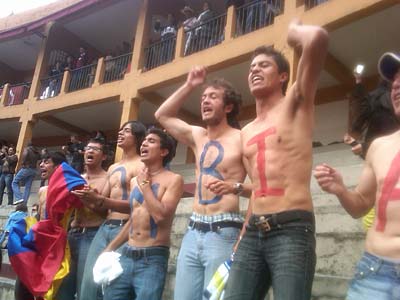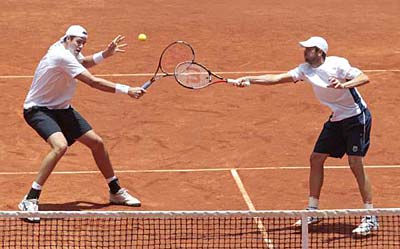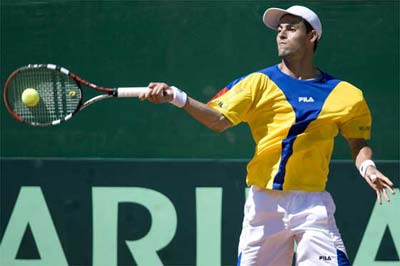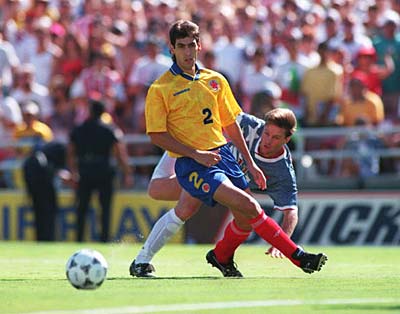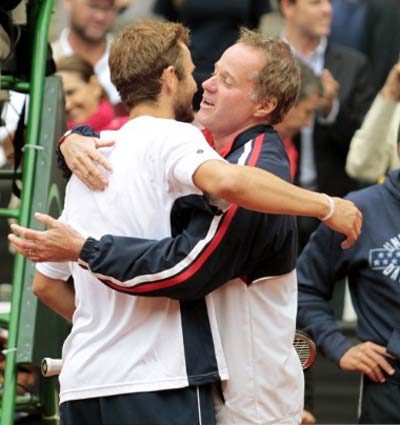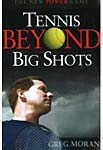| TennisOne Lessons US Beats Crowd and Columbia in Davis Cup Tie Andrew Chmura, President, Grand Slam Tennis Tours What would entice someone to travel to Bogota, Colombia? If you're not a coffee connoisseur or into other popular (although less socially acceptable) Colombian exports, why make the eight hour plus plane ride to one of the most dangerous cities in the world?
This last weekend while the Red Sox were falling out of contention and the Patriots were playing a grudge match against their rivals, the Jets, the US Davis Cup team was battling to avoid being dropped from the elite group in Davis Cup competition against a talented Colombian team. By the way, a Davis Cup "Tie" is the term used to describe a Davis Cup match between two countries. As much as we don’t like to admit it, for most Americans, tennis is not a top tier sport, but throughout South America and Colombia it is second only to football (soccer). And having a chance to beat a competitive American team at home was a tremendous opportunity for the Colombian team. Playing a Davis Cup tie in a country like Colombia has to be one of the most difficult tasks to ask for any team. Talk about home field advantage! The tie was played at 8,500 feet above sea level on the slowest of red dirt. This is not only physically strenuous but also requires a different set of strategies to be executed on the court. Because of the altitude, the tie was played with Tretorn pressure-less balls (dead tennis balls). These unique balls fly through the air like ping pong balls, then die like rotten tomatoes on the soft clay. Without proper preparation and practice, under these conditions, it is practically impossible to perform at the top of one’s game. Now add a converted bull ring (The Plaza Toros Santa Maria) with 15,000 screaming, horn blowing, drum pounding, flag waving, dancing, and chanting Colombians energizing the home team, and you have a very difficult set of circumstances to navigate, particularly for a young and inexperienced American team. Luckily, the American team of Sam Querry, John Isner, 18-year old Ryan Harrison, also had a resurgent and fit, Mardy Fish.
Day One and Two On day one, US #1 Mardy Fish rallied to a spectacular five set victory against Alejandra Falla, Colombia’s #1 player. That name should sound familiar. Falla served for the match against Federer in the first round this year’s Wimbledon. In the second match, America’s #2 player, Sam Querry, fell to a gifted Santiago Giraldo, who beat Querry soundly in three sets. On day two, the US newly formed doubles team composed of Mardy Fish and John Isner defeated the Colombian team of Robert Farah and Carlos Salamaca. This put the Americans one match from victory with two singles matches to play. This may have appeared to be a good position for the Americans, but so far, only Fish had shown the fortitude to handle the unique set of circumstances that exist in the bullring of Bogota and many felt the outcome of the tie surely rested on his shoulders. Day Three So the stage was set, so to speak, Mardy Fish, the strongest player on the team, going up against Santiago Giraldo, currently playing the best tennis of his career. The last American to win three straight points and clinch a Davis Cup tie was Pete Sampras in the 1995 finals in Moscow. Under these conditions, in front of this partisan crowd, it would be a lot to ask from Fish.
At one set each, I thought to myself, the Colombian crowd at The Plaza Toros Santa Maria inherentlypossesses more rhythm in their cheering and support of their players than any other venue I've seen. The wave seamlessly rolled around the bull ring like Baryshnikov in a never ending pirouette. The pounding of the drums sent a unified call to victory from all parts of the bull ring. The red, yellow, and blue of the Colombian flag filled each seat, and the fans waved them around with manic enthusiasm. The bull ring was literally bouncing with nationalistic pride. New York can get pretty rowdy during the US Open but I’ve never seen anything like this. One thing surprised me, the highly partisan Colombian crowd was not without sportsmanship, and they weren’t above cheering for great shots made by the American. So here we go, best of three sets to decide the tie. Up to this point, the match was kind of streaky and driven by who had control of the energy on court. This is so important in tennis, but even more important in Davis Cup competition. With a biased and supportive crowd in your favor, it’s much easier to use that energy and the confidence that comes with it. Santiago was visibly doing this, pumping his fists and playing to the crowd at every opportunity. Mardy was leaning on coach Patrick McEnroe and the 5 or 6 Americans lining the visitor’s bench for support.
A combination of errors and amazing running forehands by Giraldo, and Fish lost a break deep in the third set. Then the rains came, first a steady drizzle that made the already soft, dead clay court, even slower. Fish looked a little shaken, making more errors, and exhibiting questionable shot selection. But a timely over-rule and a nervous double fault by Giraldo handed Fish and team USA a two sets to one advantage. The crowd seemed antsy and a few seat cushions flew onto the court, aimed at Fish and team USA. Then the drizzle turned to rain and things looked really bleak. Whistles and calls from the crowd between serves became increasingly louder and more distracting. Atone all in the fourth, Mardy dove for a volley and sliced the back of his playing hand on the clay, then missed an easy volley. Blood stained Fish’s shirt, and dripped from his knee. At that point, it looked more like Fish had been in street fight than a tennis match and he seemed unnerved. A terrible service game at two all,Fish is broken, and the ring bounced to life again. Mardy Fish – Davis Cup Hero Fifth set. The whistles and attempts to distract Fish seemed to be paying off for the Colombians. If I were in Fish’s shoes, I would have been on my third cracked racquet by now… At this stage I considered offering 50 million Colombian pesos for the horn the guy behind me was blowing into my ear after every point Giraldo won.
The songs, chanting, and whistles grew louder and louder, especially when Mardy was getting ready to serve. The Atmosphere was crazed. Fish was broken at five all and the Colombians were into a frenzy. Dancing and chanting in a rhythm I only wish I had. If he could serve out the match, Giraldo had a golden opportunity to achieve immortality, a hero forever in this sports crazed country. At this stage, I wondered if he thought about Andres Escobar, the soccer star that accidentally kick the ball into his own goal and was rewarded for his efforts with nothing less than his assassination when he returned to Medellin, Colombia in 1994. This is a country that takes it sports very seriously. Before I awoke from this brutal daydream, Fish had already broken back on a trio of unforced errors by Giraldo. Fish then saved two break points and hit a couple of amazing drop volleys to take a 7-6 lead. Serving to stay in the match, the pressure on Giraldo was overwhelming and Fish was bouncing around the court as if he could taste the finish. In the end, it all proved too much for Giraldo and Fish captured the Davis Cup tie for the American team.
A sullen and broken Giraldo left the court in front of an astonished Colombian crowd. Fish dropped to the court in exhaustion and was attacked by jubilant teammates. Too often we use the word heroic to describe what happens on the sports field. And Fish’s effort and victory may not receive the press attention or the dollars that a US Open victory would, but in my estimation it was extraordinary. Mardy Fish played 14 sets in 3 days at 8,500 feet, with 15,000 screaming Colombians all cheering for his demise. He was forced to change his game many times to adjust to the conditions of the balls, the court, and the crowd. It took a Herculean effort just to survive let alone prevail, in an atmosphere like that. Walking away from this incredible match, I could not help but feel somewhat philosophical. The match ended exactly as it should have. In the face of adversity it is preparation, fortitude, and perseverance that entitle the competitor to survive. Mardy Fish displayed an abundance of these qualities and should be recognized for his heroic performance. Your comments are welcome. Let us know what you think about Andrew Chmura's article by emailing us here at TennisOne.
Tennis Beyond Big Shots presents a bold back-to-the-future approach. A new game that moves away from power and big shots yet is more lethal to opponents than any booming serve. Greg Moran shows players of all ages and abilities that, with simple and small changes, you can not only maximize your tennis wins and play longer, but also have much more fun doing it. Click link to purchase Greg Moran's book, Tennis Beyond Big Shots. |
